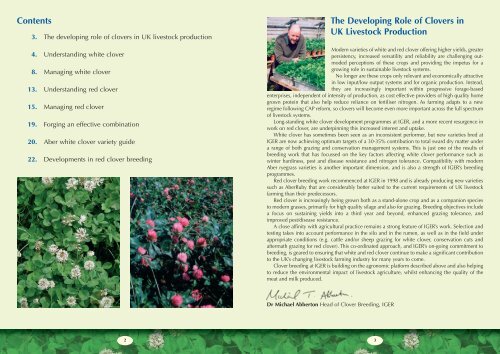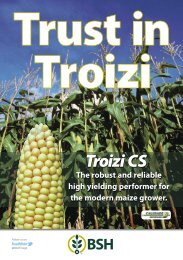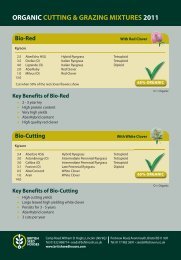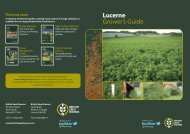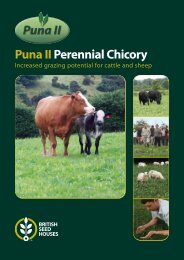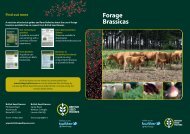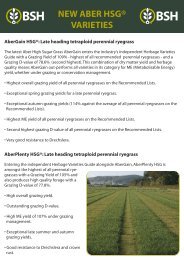Create successful ePaper yourself
Turn your PDF publications into a flip-book with our unique Google optimized e-Paper software.
Contents<br />
3. The developing role of clovers in UK livestock production<br />
4. Understanding white clover<br />
8. Managing white clover<br />
13. Understanding red clover<br />
15. Managing red clover<br />
19. Forging an effective combination<br />
20. <strong>Aber</strong> white clover variety guide<br />
22. Developments in red clover breeding<br />
The Developing Role of <strong>Clover</strong>s in<br />
UK Livestock Production<br />
Modern varieties of white and red clover offering higher yields, greater<br />
persistency, increased versatility and reliability are challenging outmoded<br />
perceptions of these crops and providing the impetus for a<br />
growing role in sustainable livestock systems.<br />
No longer are these crops only relevant and economically attractive<br />
in low input/low output systems and for organic production. Instead,<br />
they are increasingly important within progressive forage-based<br />
enterprises, independent of intensity of production, as cost effective providers of high quality home<br />
grown protein that also help reduce reliance on fertiliser nitrogen. As farming adapts to a new<br />
regime following CAP reform, so clovers will become even more important across the full spectrum<br />
of livestock systems.<br />
Long-standing white clover development programmes at IGER, and a more recent resurgence in<br />
work on red clover, are underpinning this increased interest and uptake.<br />
<strong>White</strong> clover has sometimes been seen as an inconsistent performer, but new varieties bred at<br />
IGER are now achieving optimum targets of a 30-35% contribution to total sward dry matter under<br />
a range of both grazing and conservation management systems. This is just one of the results of<br />
breeding work that has focussed on the key factors affecting white clover performance such as<br />
winter hardiness, pest and disease resistance and nitrogen tolerance. Compatibility with modern<br />
<strong>Aber</strong> ryegrass varieties is another important dimension, and is also a strength of IGER’s breeding<br />
programmes.<br />
Red clover breeding work recommenced at IGER in 1998 and is already producing new varieties<br />
such as <strong>Aber</strong>Ruby that are considerably better suited to the current requirements of UK livestock<br />
farming than their predecessors.<br />
Red clover is increasingly being grown both as a stand-alone crop and as a companion species<br />
to modern grasses, primarily for high quality silage and also for grazing. Breeding objectives include<br />
a focus on sustaining yields into a third year and beyond, enhanced grazing tolerance, and<br />
improved pest/disease resistance.<br />
A close affinity with agricultural practice remains a strong feature of IGER’s work. Selection and<br />
testing takes into account performance in the silo and in the rumen, as well as in the field under<br />
appropriate conditions (e.g. cattle and/or sheep grazing for white clover, conservation cuts and<br />
aftermath grazing for red clover). This co-ordinated approach, and IGER’s on-going commitment to<br />
breeding, is geared to ensuring that white and red clover continue to make a significant contribution<br />
to the UK’s changing livestock farming industry for many years to come.<br />
<strong>Clover</strong> breeding at IGER is building on the agronomic platform described above and also helping<br />
to reduce the environmental impact of livestock agriculture, whilst enhancing the quality of the<br />
meat and milk produced.<br />
Dr Michael Abberton Head of <strong>Clover</strong> Breeding, IGER<br />
2 3


